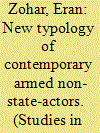| Srl | Item |
| 1 |
ID:
144881


|
|
|
|
|
| Summary/Abstract |
This study analyzes contemporary non-state-actors (NSAs) finding four major categories: secessionist organizations fighting for a federal regime or full independence. These have a homogenous character and are domestically oriented. Secessionist NSAs that enjoy strong sponsorship are running a state within a state, possessing regular forces. Second, radical left revolutionary NSAs are fighting to overthrow the existing social order and to relocate power within a country. Arming with limited weaponry that they steal and purchase, they wage guerrilla war from dense jungles and rough mountains. Sectarian-based revolutionary NSAs seek regime change to stop state marginalization. They could evolve into a regular force, armed with heavy weapons. The fourth category and the most powerful is the global revolutionary organizations. They are religious based, seeking to impose Islamic rule in their own countries or worldwide through jihad. They are transnational, specializing in suicide bombing and sophisticated martyrdom assaults.
|
|
|
|
|
|
|
|
|
|
|
|
|
|
|
|
| 2 |
ID:
175588


|
|
|
|
|
| Summary/Abstract |
One recurring theme of the immediate post-9/11 environment was that of regional political organizations and violent lone-wolf actors pledging allegiance to Osama bin Laden’s Al Qaeda group (AQ). Following the Islamic State of Iraq and Syria (ISIS)’s 2014 capture of Mosul, Iraq, many of these loose affiliations began shifting to ISIS. This resulted in a blurring of distinctions between different types of Sunni jihadi organizations, with media commentators and analysts at times referring to groups as “Al Qaeda–like” or “ISIS-affiliated,” despite those groups’ goals and operational scopes being largely disconnected from both AQ and ISIS. This article proposes a new typology of Sunni jihadi groups according to theater of operation, strategy, and geopolitical alignment. This typology offers three categories: global jihad, local jihad, and sectarian jihad. In addition, it identifies four types of operation types that Sunni jihadi groups adopt: (1) core theater attacks, (2) power-projection attacks, (3) local recruitment, and (4) foreign recruitment. The main contribution of this article is its frameworks for improving the quality of the analysis of Sunni jihadi groups.
|
|
|
|
|
|
|
|
|
|
|
|
|
|
|
|
| 3 |
ID:
114928


|
|
|
|
|
| Publication |
2012.
|
| Summary/Abstract |
The development of demands advanced by ethnic minorities has received broad coverage in the scholarly literature on divided societies. Current literature offers models that predict a radicalization of minority demands as the result of diverse factors, including modernization processes, discrimination, and a mother country's support for the minority's demands. The present article offers an alternative approach, one that combines the type of minority with the type of regime as fundamental elements that shape a minority's demands. The model presented in this article distinguishes between four situations in which minorities might find themselves: an indigenous minority living in a democratic regime; an immigrant minority living in a democratic regime; an indigenous minority living in an ethnocratic regime, and an immigrant minority living in an ethnocratic regime. The demands that a minority will develop in these different situations range along an axis from radical to moderate and from secession to integration on the basis of equality in a reconstituted state. As part of my analysis, I cite several examples of minority demands across the world.
|
|
|
|
|
|
|
|
|
|
|
|
|
|
|
|